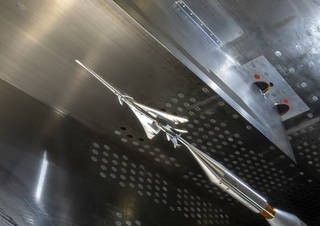NASA has tested a prototype of its new "quiet" supersonic jet, dubbed "Son of Concorde," which will replace the sonic boom with a quieter "thump" when it takes to the skies.
After the Federal Aviation Administration (FAA) barred supersonic commercial flights, the space agency intends to remove the prohibition by substituting the deafening sonic boom with a softer "sonic thump."
According to Aerospace Manufacturing, a sonic boom occurs when shock waves from an item traveling faster than the speed of sound join together before reaching the earth. Sonic booms produce huge amounts of sound energy, roughly 110 decibels, similar to an explosion or a thunderclap, and maybe heard up to 30 miles (48 kilometers) distant.

NASA Upgrades Supersonic Jet 'Son of Concorde'
In NASA Glenn's 8-by-6-foot Supersonic Wind Tunnel, engineers working on the Commercial Supersonic Technology (CST) project tested the agency's boom-reducing technology and its forecasting skills on a small-scale model X-59 Quiet SuperSonic Technology (QueSST) jet. The X-59 has been termed the "Son of Concorde." Interesting Engineering said this was the world's first supersonic passenger-carrying commercial airliner. Daily Mail noted that Concorde, which retired in 2003, made a loud and shocking sonic boom.
The full-scale X-59 QueSST is now being built at Lockheed Martin's Skunk Works division in Palmdale, California, by NASA and Lockheed Martin. NASA said the first testing of the supersonic plane would begin in late 2022. If the plane passes the tests, NASA will ensure that the aircraft's silent supersonic technology functions as expected in flight.
Meanwhile, NASA put the small-scale replica through its paces for two weeks. The shock wave observations matched the computer-modeled shock waves, indicating that quieter supersonic flights are possible.
If the X-59 can reduce the sound of sonic booms and supersonic flights are approved for commercial use, it might fly from London to New York in about three hours. The aircraft, which measures 29.5 meters (99.7 feet) in length and 9 meters (29.5 feet) in width, is meant to reduce the sound of sonic booms.
NASA Tries to Bring the Supersonic Aircraft Back to Life
According to CBS News, NASA collaborated with startups and United Airlines to reintroduce supersonic commercial flights, which were put on hold more than a decade ago because of safety concerns. It comes only a few years after the supersonic plane's tragic accident in 2000 prompted recurrent safety worries.
Although the super-fast flight was accessible, it was only offered on a few itineraries. In the form of British Airways Flight 002, the last supersonic flight took place on Oct. 24, 2003, signaling the end of the speedy commercial aircraft.
Blake Scholl, the CEO and creator of the business Boom, told Bill Whitaker of "60 Minutes" that his company is producing a supersonic aircraft, which is making a comeback after years away.
Furthermore, according to CBS News, Boom is not alone in his efforts to bring supersonic flying back to the commercial market. Other companies, such as Spike, which builds elegant ultra-fast airplanes, and Hermeus, which wants to build hypersonic planes, are following in their footsteps.
It's worth noting, though, that Scholl's American venture is the only one planning to create a real supersonic jet that has flown before.
RELATED ARTICLE : NASA's X-59 Spacecraft: Lockheed Martin's 'Quietest' Aircraft's First Flight Approaching Soon
Check out more news and information on Space in Science Times.
© 2025 ScienceTimes.com All rights reserved. Do not reproduce without permission. The window to the world of Science Times.












